Listen (text to speech)
During the Revolution, America benefited from the Spanish and French navies laying siege to British controlled Gibraltar.
It was the longest siege the British ever endured, and one of the longest in naval history, requiring an enormous amount of British military resources that otherwise would have been sent to stop the American Revolution.
During this time, on the night of August 8, 1780, a large convoy of British ships and merchant vessels left the English Channel.
In the dark, Spanish Admiral Luis de Córdova y Córdova slipped his flagship between the lead British ship and the rest of the British fleet.
Córdova mimicked the signal shots of the lead ship to fool the British convoy into following him.
When dawn broke, the British convoy was shocked to find they were surrounded in a trap.
A British officer wrote: “At day-light we found ourselves in the centre of thirty ships of the line and four frigates. We tried to run, but found it impossible.”
It was one of the largest naval captures in history, 55 ships containing over a million British pounds of supplies, including 80,000 muskets, equipment for 40,000 troops, 294 cannons, uniforms and gold bars, much of which was intended for British troops fighting in America.
Together with France's King Louis XVI, Carlos III of Spain secretly supplied five million livres worth of materials and arms to America through a front trading business called "Roderigue Hortalez and Company."
The company covertly worked with Connecticut merchant Silas Deane and Thomas Morris, the half-brother of Robert Morris, the "Financier of the Revolution."
Dutch merchants similarly funneled supplies and weapons secretly to America through the Island of St. Eustatius, including muskets, cannons, cannonballs, gunpowder, bombs, mortars, tents, and clothing enough for 30,000 soldiers.
As the British ships blockaded the ports of America's 13 colonies, King Carlos III gave a directive to the Spanish Governor of Louisiana, Bernardo de Gálvez, to allow military supplies, weapons, cartridge boxes, uniforms, and medicine to be shipped through the Caribbean up the Mississippi River to the Ohio River to Pittsburgh, from where they could be transported overland to Philadelphia to aid the Continental Army troops under the command of General Washington and Brigadier-General George Rogers Clark.
In 1777, the value of the supplies delivered was over $70,000.
Barnardo de Gálvez's uncle, José de Gálvez, was Inspector General of New Spain, where he appointed the Franciscan Junipero Serra to lead the 21 missions in California. Serra was a tireless missionary, baptizing over 6,000, a tenth of the native population in that area.
Bernardo de Gálvez corresponded with Thomas Jefferson, Patrick Henry, and American General Charles Henry Lee.
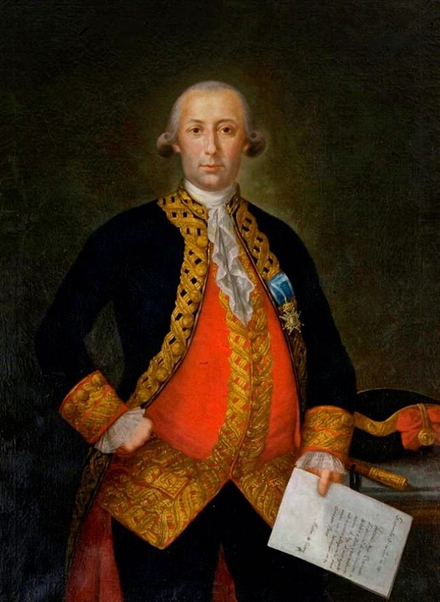
In 1779, Spain officially declared war on Britain, as did France and The Netherlands, which stretched Britain's military forces, benefitting America.
Gálvez assembled 32 ships and recruited troops from Spain, Cuba, México, Santo Domingo, Puerto Rico, Venezuela, Costa Rica, Canary Islands, free Blacks, Indians, Creoles, and French Catholic Acadians -"Cajuns."
He negotiated with the Spanish Governor of Texas, Domingo y Robles, in June, 1779, for hundreds of horses, as well as 2,000 head of cattle to be driven to New Orleans, Louisiana, to feed his troops.
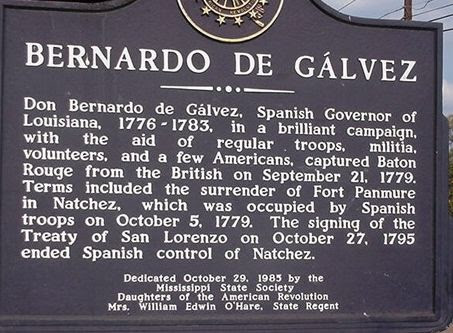
In late August, 1779, Gálvez's Spanish forces, numbering 1,427, departed from New Orleans to defeat the British at Fort Bute in Bayou Manchac, September 6, 1779.
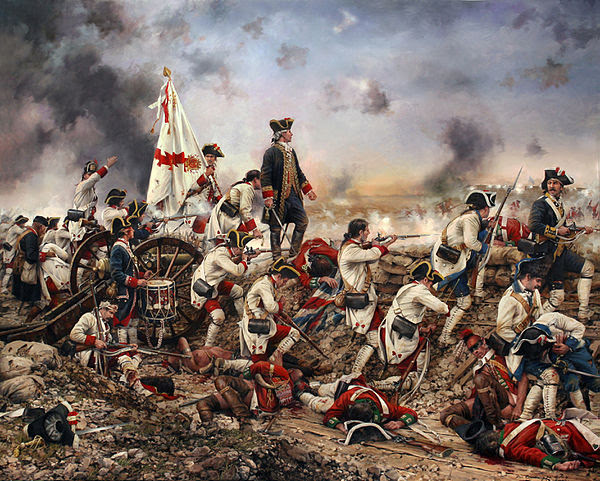 On September 21, 1779, they captured Fort New Richmond in Baton Rouge, and then captured Fort Panmure in Natchez, October 5, 1779, freeing up the lower Mississippi Valley.
On September 21, 1779, they captured Fort New Richmond in Baton Rouge, and then captured Fort Panmure in Natchez, October 5, 1779, freeing up the lower Mississippi Valley.
Increasing his troop size to 2,000, Gálvez laid a month-long land and sea siege of Fort Charlotte in Mobile, capturing it on March 14, 1780.
Fort Charlotte, called by the French Fort Conde, had been captured by the British, together with West Florida, during the French and Indian War, 1763.
The Fort Charlotte Museum exhibit states:
"British Colonial period on the Gulf Coast ended in spectacular fashion during the American Revolution ...
In March 1780, Don Bernardo de Gálvez, the Spanish governor of Louisiana, led more than a thousand troops to Mobile and laid siege to Fort Charlotte ...
For 14 long days, Spanish guns battered the old fort.
Faced with the complete destruction of his ragtag army of 300 men, including armed slaves and volunteers from the town, Captain Elias Dumford surrendered Fort Charlotte."
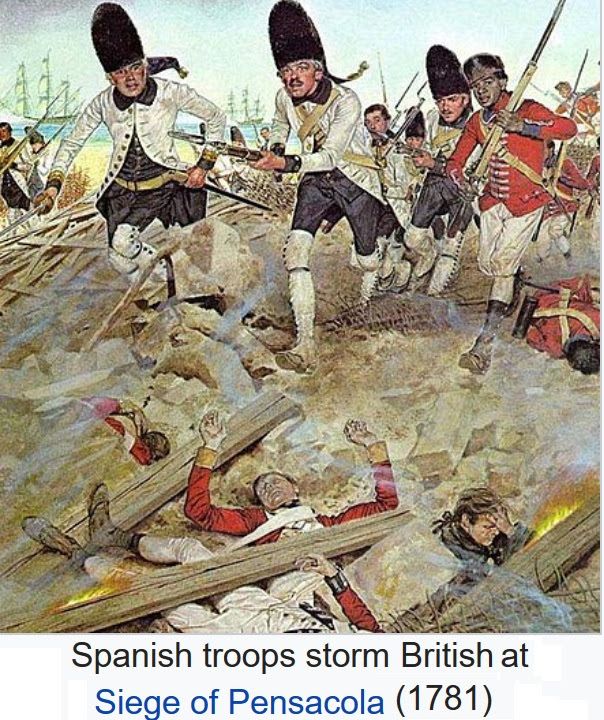
On May 8, 1782, Gálvez's Spanish forces captured the British naval base at New Providence, Nassau, Bahamas.
This effectively drove the British out of West Florida and the Gulf coast.
Gálvez also sent reinforcements to St. Louis, near where the Missouri and Mississippi Rivers meet, to repel the British and their Indian allies in the Battle of Fort San Carlos, May 25, 1780.
On February 12, 1781, Spanish soldiers from St. Louis traveled north and briefly captured Fort St. Joseph in Michigan.
Gálvez's actions prevented the British from attacking Washington's army from the west.
He was preparing a Spanish military campaign against British Jamaica when the war ended.
In 1783, Gálvez went to France where he participated in negotiations culminating in the draft the Treaty of Paris, ending the Revolutionary War.
In gratitude for his support of America, General Washington invited Gálvez to ride next to him in the July 4, 1783, victory parade in Philadelphia.
In October of 1784, Carlos III made Gálvez the Governor of Cuba, Louisiana and the Floridas, where, as a gesture of goodwill, he released all American sailors imprisoned for smuggling.
In 1785, he succeeded his father as Viceroy of New Spain and moved his family to Mexico City, which was suffering disease and famine.
Gálvez used his personal fortune to help the people of Mexico City.
He repaired the Castle of Chapultepec and completed the Cathedral of Mexico, the largest Catholic cathedral in the western hemisphere. After his death, November 30, 1786, his heart was placed there in an urn.
Congress awarded Gálvez honorary American citizenship - one of only seven other people to be thus recognized.
A U.S. postage stamp bears his image.

Statues of him are in New Orlean's Spanish Plaza, and near the U.S. Department of State, Virginia Avenue and 22nd Street N.W., Washington, DC, which was dedicated by King Juan Carlos I, June 3, 1976, with the inscription:
"BERNARDO DE GALVEZ (COUNT DE GALVEZ) 1746-1786
THE GREAT SPANISH SOLDIER CARRIED OUT A COURAGEOUS CAMPAIGN IN LANDS BORDERING THE LOWER MISSISSIPPI.
THIS MASTERPIECE OF MILITARY STRATEGY LIGHTENED THE PRESSURE OF THE ENGLISH IN THE WAR AGAINST THE AMERICAN SETTLERS WHO WERE FIGHTING FOR THEIR INDEPENDENCE.
MAY THE STATUE OF BERNARDO DE GALVEZ SERVE AS A REMINDER THAT SPAIN OFFERED THE BLOOD OF HER SOLDIERS FOR THE CAUSE OF AMERICAN INDEPENDENCE."
Spain also funded Washington's victory over the British at the Battle of Yorktown.
Ben Franklin and Marquis de Lafayette were successful in persuading French King Louis XVI to send ships to help Americans.
One their way over, they stopped off at Haiti looking for funds.
French Admiral de Grasse wrote to General Jean Baptiste de Rochambeau, June 28, 1781:
"Saint-Domingue Colony (Haiti) has no money, but I will send a frigate to Havana in quest of it."
General Lafayette’s frigate L'Aigrette was send to the Port of Havana , September 1781, to obtain water and supplies to bring to Washington’s army in Virginia.
While there, Cuba’s Governor General Juan Manuel de Cagigal y Monserrat organized a fundraising campaign.
When word spread, Cuban women from Havana to Matanzas to Pinar del Rio, donated gold, silver, jewelry, silverware, and candelabras, estimated at several million dollars, to be carried on the French ships to General Washington at Yorktown.
The Ladies of Havana included the note: "So the American mothers’ sons are not born as slaves."
When General Washington received the gift, he reportedly threw his hat in the air.
General Rochambeau wrote in his Daily Memoirs (Library of Congress):
"The joy was enormous when it was received, the money from Havana: The contribution of 800,000 silver pounds which helped stop the financial bankruptcy (of the Revolutionary Army) and raised up the moral spirit of the Army that had began to dissolve."
Pulitzer Prize winning Historian Stephen Bonsal, who served in the U.S. embassy in Madrid, wrote in When the French Were Here (Doubleday, Doran & Co.,1945):
"The million that was supplied ... by the ladies of Havana may, with truth, be regarded as the 'bottom dollars’ upon which the edifice of American independence was erected.
The contribution of Cuban women by way of their jewelry, could very well be the foundation on which is founded, the freedom of the United States."
A Spanish sea captain help America's fledging navy.
Jorge Antonio Martín Farragut y Mesquida was born in Menorca, Spain. At the age of 10, he went to sea, and eventually became a Spanish merchant captain.
Crossing the Atlantic to the Caribbean, he commanded a vessel trading goods between Havana, Cuba; Veracruz, Mexico; and New Orleans.
In 1766, Jorge Farragut moved from Spain to America, where he changed his name to George Farragut.
He became a patriot and joined in the Revolutionary War against Britain.
He served as a lieutenant in the South Carolina Navy and then the Continental Navy.
Farragut fought the British at Savannah in 1779; was captured in the Siege of Charleston, 1780; then fought in the Battles of Cowpens and Wilmington, 1781.
After the Revolution, George Farragut, with his wife, Elizabeth, helped found Knoxville, Tennessee, where their son, David Glasgow Farragut, was born.
After Jefferson's Louisiana Purchase, the Farraguts moved to New Orleans.
New Orleans had been a French city till the British won the French and Indian War. Rather than letting the British get it, France secretly gave it to Spain with the Treaty of Fountainbleau, 1762.
It was the capital of Spanish Luisiana till Napoleon invaded Spain and took it back with the Treaty of Ildefonso, 1800, then sold it to the U.S. with the Louisiana Purchase, 1803.
Spanish Captain George "Jorge" Farragut's son, David Glasgow Farragut, went on to be a hero in the War of 1812, after which he was made the first U.S. Navy Admiral.
--
Download as PDF ...
American Minute is a registered trademark of William J. Federer. Permission granted to forward, reprint, or duplicate.
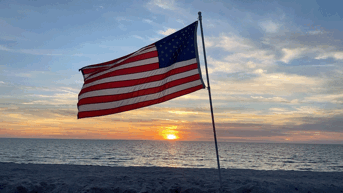

Thank you sir for the wonderful article.
An erudite presentation of American History (so entertainingly done) of which i for one, was near in total ignorance. ….Mr Federer always presents History with its attendant action of Virtue as the ‘natural outcome’ of Divine Providence – - thank you, Bill and shalom to you.